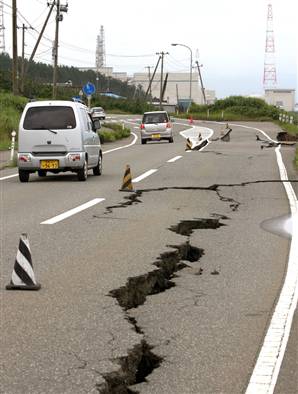The Japanese Earthquake On March 11th, 2011 Moved the Earth On Its Axis
 Today I found out that the earthquake in Japan on March, 11, moved the Earth on its axis by about 4 to 6 inches, which resulted in shortening of a day by around 1.8 microseconds.
Today I found out that the earthquake in Japan on March, 11, moved the Earth on its axis by about 4 to 6 inches, which resulted in shortening of a day by around 1.8 microseconds.
Massive earthquakes typically affect the Earth’s rotation with the impact of every individual earthquake depending on its magnitude, location, and the details of how the fault slipped. The 8.9/9.0 magnitude earthquake which hit the Pacific Ocean near Northeastern Japan at around 2:46 pm on March, 11 caused extreme damage and unleashed a devastating tsunami a day after, when waves crashed 10 kilometers inland.
This was the largest earthquake ever recorded in Japan and the subsequent tsunami traveled across the Pacific Ocean, reaching as far as the western coasts of Canada, the U.S. and Chile. In addition to this, during the first 24 hours, the initial earthquake triggered more than 160 aftershocks.
Reports from the National Institute of Geophysics and Volcanology in Italy estimated that this recent earthquake shifted the planet on its axis by nearly 4 inches (10 centimeters). Other scientists put that figure at closer to 6.5 inches (17 centimeters).
When the axis on which the planet’s mass is balanced slightly shifts, it causes changes in the length of time for the Earth to make a complete rotation. The Japanese earthquake changed the distribution of Earth’s mass shifting it towards the center. This resulted in the planet spinning a tiny bit faster, shortening the length of the day by about 1.8 microseconds (a microsecond is one millionth of a second). For reference, one Earth day is approximately 86,400 seconds long.
Experts say that this earthquake was caused when the Earth’s crust shifted along an area about 250 miles long by 100 miles wide. The Pacific tectonic plate dove under the North American plate deep underwater, with the plates slipping more than 18 meters overall.
Bonus Facts:
- According to a US Geological Survey, as a result of the earthquake, the main island of Japan was moved by around 8 feet (2.4 meters) closer to North America. The shape of the country’s coastline was also changed.
- Japan is located along the Pacific ‘ring of fire’, on the edges of several continental and oceanic tectonic plates. This is an area of high seismic and volcanic activity from New Zealand, up through Japan, across to Alaska, and down the west coasts of North and South America. Japan’s specific location in this “ring”, causes frequent earthquakes as well as many volcanoes and hot springs across the country.
- The particular Japanese earthquake was the fifth most powerful earthquake during the past century.
- The earthquake in Chile in 2010 had an 8.8 magnitude. It also sped up the earth’s rotation and shaved 1.26 microseconds off the day.
- The Great Kanto Earthquake, which hit the Kanto plain around Tokyo in 1923, was also particularly horrific, resulting in the deaths of over 100,000 people.
- The Japanese use a special ‘shindo’ scale for measuring earthquakes, which is different from the more common Richter scale. Shindo refers to the intensity of an earthquake at a given location, while the Richter scale measures the magnitude – the energy an earthquake releases at the epicenter. The shindo scale ranges from shindo one (a slight earthquake felt only by people who are not moving) to shindo seven – an earthquake which causes severe damage.
Expand for References:
| Share the Knowledge! |
|





In relation to what? As in the inclination of the axis?
Interesting article; maybe eventually the day might be shortened to only 23 hours!